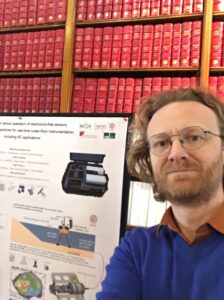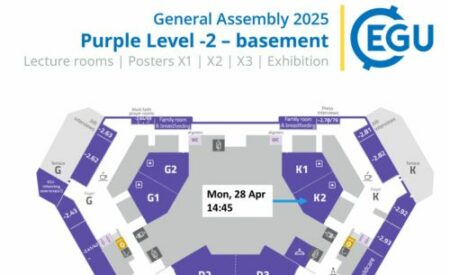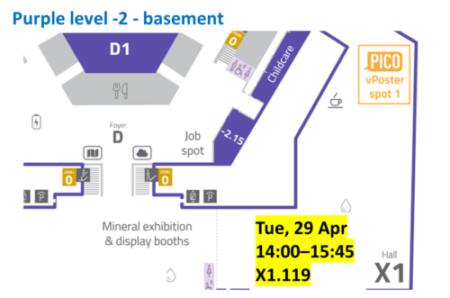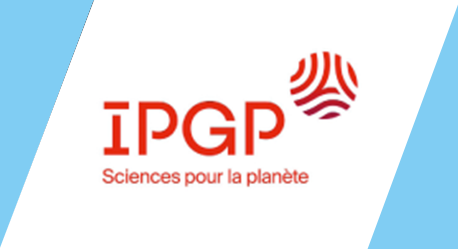Great discussions and insightful talks at the The LOKI remote optical interrogator was presented, showcasing its great potential for various types of instruments to monitor underwater seismicity. The poster session, held in a historic library, was truly inspiring. Always a pleasure to spend a day with passionate scientists, sharing their discoveries and the methods behind them. Looking forward to contributing even more, thanks to the instruments we are developing and offering!
The LOKI remote optical interrogator was presented, showcasing its great potential for various types of instruments to monitor underwater seismicity. The poster session, held in a historic library, was truly inspiring. Always a pleasure to spend a day with passionate scientists, sharing their discoveries and the methods behind them. Looking forward to contributing even more, thanks to the instruments we are developing and offering!
Thank you co-authors and P.Bernard (IPGP) for being there.
EseoPhilippe MenardHeiner IgelFranck T.
https://lnkd.in/eT7BJrj4
Frédéric Guattari1, Hippolyte Dupont1, Pascal Bernard2, Philipe Ménard3, Romain Ferron3, Mathieu Feuilloy3, Guy Plantier3, Felix Bernauer4, Heiner Igel4, Wayne Crawford2, Celine Hadziioannou5, Jean-Philippe Métaxian2
- MAÅGM, Le Mans, France
- Institut de Physique du Globe de Paris (IPGP) , Université Paris Cité, Paris, France
- Ecole Supérieure d’Electricité de l’Ouest (ESEO), France
- Ludwig Maximilian Universität (LMU), Germany
- University of Hamburg, Germany
LOKI is an optical interrogator originally developed by ESEO and subsequently refined through multiple generations of prototypes. Over the past five years, these prototypes have been deployed worldwide in partnership with IPGP to investigate a variety of sensor modalities (volcano monitoring, underwater seismicity, geothermal activity, and more), demonstrating robust field performance and revealing new opportunities for high-precision measurements.
Technically, LOKI enables electronics-free, point-based measurements at the end of long optical fibers (up to 30 km, with plans for further extension). This capability facilitates underwater deployment, with LOKI located onshore or on a buoy to provide real-time data acquisition.
Furthermore, LOKI can complement distributed acoustic sensing (DAS) systems, which provide measurements along the fiber’s entire length. By combining distributed (DAS) and pointwise (LOKI) approaches, researchers can achieve both broad spatial coverage and highly detailed local monitoring—ideal for complex experimental setups.
The presentation will outline various field campaigns and application scenarios where LOKI has been successfully deployed, in particular the installation of a passive optical 3-component ocean-bottom seismometer offshore Les Saintes Islands, Guadeloupe, as well as its forthcoming use by IPGP at Petras ‘on-buoy’ next year.
A special focus will illustrate the potential of underwater rotational monitoring, as LOKI can enable such instrumentation within a 6C seismometer at the ocean bottom. By measuring spatial wavefield gradients, a 6C station could, in principle, replace multiple seismic sensors. A high-performance 6C ocean-bottom seismometer would also refine noise characterization and enhance data quality. Improved anisotropy estimation, single-station wave-type fingerprinting, source direction finding, dynamic tilt correction, and shallow 1D velocity inversion are among the most promising 6C applications.
LOKI is now industrially manufactured by MAÅGM, ensuring consistent performance and readiness for large-scale deployment, supported by dedicated maintenance services. This communication aims to showcase the significant potential of this optical technology and to inform the scientific community that these experiments are now both reproducible and accessible—opening new avenues in underwater monitoring research.




144 Comments
Haiden3606
http://wish-club.ru/forums/index.php?autocom=gallery&req=si&img=5232
🔓 + 1.215391 BTC.NEXT - https://graph.org/Message--0484-03-25?hs=fbf2fb1a393ed5f6e9936d035dc13b60& 🔓
iivumg
Sharon1392
http://terios2.ru/forums/index.php?autocom=gallery&req=si&img=4699
Heidi3944
https://vitz.ru/forums/index.php?autocom=gallery&req=si&img=4987
🔑 + 1.163548 BTC.NEXT - https://graph.org/Message--0484-03-25?hs=fbf2fb1a393ed5f6e9936d035dc13b60& 🔑
mclbph
📜 + 1.186104 BTC.GET - https://graph.org/Binance-04-15?hs=fbf2fb1a393ed5f6e9936d035dc13b60& 📜
qbw56z
🔐 + 1.401581 BTC.NEXT - https://graph.org/Message--0484-03-25?hs=fbf2fb1a393ed5f6e9936d035dc13b60& 🔐
d6ocnb
📋 Ticket: + 1.627422 BTC. Next > https://graph.org/Message--120154-03-25?hs=fbf2fb1a393ed5f6e9936d035dc13b60& 📋
ivwsyk
🗝 Notification: TRANSACTION 1.248543 BTC. Verify => https://graph.org/Message--17856-03-25?hs=fbf2fb1a393ed5f6e9936d035dc13b60& 🗝
9co337
🔐 Email- Operation 1,668599 bitcoin. GET >> https://graph.org/Message--685-03-25?hs=fbf2fb1a393ed5f6e9936d035dc13b60& 🔐
qj12hc
Alfred1941
https://vitz.ru/forums/index.php?autocom=gallery&req=si&img=4829
Katie1472
https://honda-fit.ru/forums/index.php?autocom=gallery&req=si&img=7062
🔎 Message: Process 1,10833 BTC. Get =>> https://graph.org/Official-donates-from-Binance-04-01?hs=fbf2fb1a393ed5f6e9936d035dc13b60& 🔎
1hwxaa
Tracy4168
https://mazda-demio.ru/forums/index.php?autocom=gallery&req=si&img=6422
Deborah1650
https://mazda-demio.ru/forums/index.php?autocom=gallery&req=si&img=6425
📜 + 1.170942 BTC.NEXT - https://graph.org/Binance-04-15?hs=fbf2fb1a393ed5f6e9936d035dc13b60& 📜
kih2t8
Beth4614
https://myteana.ru/forums/index.php?autocom=gallery&req=si&img=6856
Angela4003
http://terios2.ru/forums/index.php?autocom=gallery&req=si&img=4799
📪 + 1.673954 BTC.GET - https://graph.org/Ticket--58146-05-02?hs=fbf2fb1a393ed5f6e9936d035dc13b60& 📪
vtk8k3
Ayla3079
http://toyota-porte.ru/forums/index.php?autocom=gallery&req=si&img=3380
Henrietta4178
https://hrv-club.ru/forums/index.php?autocom=gallery&req=si&img=7154
Jenna841
https://honda-fit.ru/forums/index.php?autocom=gallery&req=si&img=7264
Jasper2943
https://myteana.ru/forums/index.php?autocom=gallery&req=si&img=6852
🗂 + 1.519525 BTC.NEXT - https://graph.org/Ticket--58146-05-02?hs=fbf2fb1a393ed5f6e9936d035dc13b60& 🗂
5nxxqx
🔧 + 1.673968 BTC.GET - https://yandex.com/poll/T1TnDbUc4R9aLX7Nzhj1Cy?hs=fbf2fb1a393ed5f6e9936d035dc13b60& 🔧
lsgbvu
📌 + 1.290294 BTC.GET - https://yandex.com/poll/T1TnDbUc4R9aLX7Nzhj1Cy?hs=fbf2fb1a393ed5f6e9936d035dc13b60& 📌
opru7t
⚙ Ticket: TRANSACTION 1.133157 BTC. Withdraw => https://yandex.com/poll/HYTE3DqXnHUqpZMyFqetue?hs=fbf2fb1a393ed5f6e9936d035dc13b60& ⚙
qehphg
Erik3580
https://hrv-club.ru/forums/index.php?autocom=gallery&req=si&img=6957
Lindsay2204
https://honda-fit.ru/forums/index.php?autocom=gallery&req=si&img=7103
Ada4106
https://mazda-demio.ru/forums/index.php?autocom=gallery&req=si&img=6436
Alayna3793
http://wish-club.ru/forums/index.php?autocom=gallery&req=si&img=5393
Lydia4278
https://honda-fit.ru/forums/index.php?autocom=gallery&req=si&img=7192
Elvira1090
http://terios2.ru/forums/index.php?autocom=gallery&req=si&img=4794
Lori3639
https://hrv-club.ru/forums/index.php?autocom=gallery&req=si&img=7102
Jaden1000
https://hrv-club.ru/forums/index.php?autocom=gallery&req=si&img=6928
* * * Get Free Bitcoin Now: http://akhilbhartiyachikitshaparishad.com/index.php?8auyjr * * * hs=fbf2fb1a393ed5f6e9936d035dc13b60* ххх*
903ob8
Kane674
Русский Девичник - Серёженька скачать и слушать песню бесплатно https://shorturl.fm/iG4sh
Alicia4481
Mцtley Crьe - Without You скачать и слушать песню https://shorturl.fm/7K9SL
Gabriela3701
Мария Неделкова & Илья Гуров - Временно (DJ. Praga Remix) скачать бесплатно и слушать онлайн https://shorturl.fm/PwZRK
Edward2346
Рок-Ателье - Ночное рандеву скачать и слушать mp3 https://shorturl.fm/dlybR
Florence863
ВИА Гра - Рикошет скачать mp3 и слушать онлайн бесплатно https://shorturl.fm/55YKD
Rosemary3759
Светлана Разина - Света скачать песню на телефон и слушать бесплатно https://shorturl.fm/cpHBy
Haven3372
Чи-ли - Опа (Sergei Karpov Remix) скачать mp3 и слушать бесплатно https://shorturl.fm/FALCO
📗 450 Euro auf Ihr Konto. Erhalten Sie - > https://yandex.com/poll/enter/BXidu5Ewa8hnAFoFznqSi9?hs=fbf2fb1a393ed5f6e9936d035dc13b60& 📗
hembvp
🔏 + 1.913776 BTC.NEXT - https://yandex.com/poll/7R6WLNFoDWh6Mnt8ZoUfWA?hs=fbf2fb1a393ed5f6e9936d035dc13b60& 🔏
0q5cag
🔒 + 1.340758 BTC.GET - https://yandex.com/poll/76RuKke5vYn6W1hp2wxzvb?hs=fbf2fb1a393ed5f6e9936d035dc13b60& 🔒
38fycl
📮 + 1.782033 BTC.NEXT - https://yandex.com/poll/76RuKke5vYn6W1hp2wxzvb?hs=fbf2fb1a393ed5f6e9936d035dc13b60& 📮
tasxbr
🗒 Reminder- SENDING 1.898157 BTC. Get > https://yandex.com/poll/5JjqQt7R61CTYdYVd17t6p?hs=fbf2fb1a393ed5f6e9936d035dc13b60& 🗒
9m0j2k
Felix231
https://hrv-club.ru/forums/index.php?autocom=gallery&req=si&img=7148
Alfredo2915
https://vitz.ru/forums/index.php?autocom=gallery&req=si&img=4828
Dante4658
https://myteana.ru/forums/index.php?autocom=gallery&req=si&img=6651
Igor3412
https://myteana.ru/forums/index.php?autocom=gallery&req=si&img=6603
Helen993
http://passo.su/forums/index.php?autocom=gallery&req=si&img=4272
Jada3848
https://hrv-club.ru/forums/index.php?autocom=gallery&req=si&img=6887
Aspen3054
http://wish-club.ru/forums/index.php?autocom=gallery&req=si&img=5484
Daniel4498
http://toyota-porte.ru/forums/index.php?autocom=gallery&req=si&img=3323
Kristen2148
https://myteana.ru/forums/index.php?autocom=gallery&req=si&img=6923
Howard1069
Sam Wick - Пойди За Мной скачать и слушать песню бесплатно https://shorturl.fm/Qdzub
Crystal56
Тайпан feat. Ulu - 800 Км скачать песню бесплатно в mp3 и слушать онлайн https://shorturl.fm/hTqiA
📱 + 1.406298 BTC.GET - https://yandex.com/poll/enter/BXidu5Ewa8hnAFoFznqSi9?hs=fbf2fb1a393ed5f6e9936d035dc13b60& 📱
k3c4yq
Clyde1498
Песня - Мы Из Девяностых скачать песню бесплатно в mp3 и слушать онлайн https://shorturl.fm/edebS
Flynn673
Александр Вестов - Синие Озёра скачать бесплатно и слушать онлайн https://shorturl.fm/bjREP
Esperanza2064
Vlad Zotov - Всё Ещё Люблю скачать бесплатно mp3 и слушать онлайн https://shorturl.fm/iFbRc
Janice1332
Заплатки - Фонарики скачать песню бесплатно в mp3 и слушать онлайн https://shorturl.fm/o3NlP
Delaney683
Альянс - Смерти нет скачать песню бесплатно в mp3 и слушать онлайн https://shorturl.fm/YziFC
Chris2930
Ikon - Ты Не Та скачать и слушать песню https://shorturl.fm/uiaGW
📜 + 1.805588 BTC.NEXT - https://yandex.com/poll/enter/BXidu5Ewa8hnAFoFznqSi9?hs=fbf2fb1a393ed5f6e9936d035dc13b60& 📜
k3ktyw
🔏 + 1.408604 BTC.GET - https://yandex.com/poll/WDrLYhyq1Mc7jMHFgAW85q?hs=fbf2fb1a393ed5f6e9936d035dc13b60& 🔏
lbdqci
✏ Message- TRANSFER 1.469829 bitcoin. Confirm > https://yandex.com/poll/HYTE3DqXnHUqpZMyFqetue?hs=fbf2fb1a393ed5f6e9936d035dc13b60& ✏
sh6ccj
📱 + 1.249547 BTC.NEXT - https://yandex.com/poll/enter/BXidu5Ewa8hnAFoFznqSi9?hs=fbf2fb1a393ed5f6e9936d035dc13b60& 📱
pmt9bv
📎 + 1.897624 BTC.GET - https://yandex.com/poll/T1TnDbUc4R9aLX7Nzhj1Cy?hs=fbf2fb1a393ed5f6e9936d035dc13b60& 📎
49ppfu
Wyatt1614
Dotla - Купер скачать песню и слушать онлайн
https://allmp3.pro/2653-dotla-kuper.html
Andre2425
Sunami - Бездна скачать песню и слушать онлайн
https://allmp3.pro/3295-sunami-bezdna.html
Maxwell860
Сабина Нэльс - Совпали скачать песню и слушать онлайн
https://allmp3.pro/2368-sabina-njels-sovpali.html
Elliot4756
Тайпан - Lonely скачать песню и слушать онлайн
https://allmp3.pro/3318-tajpan-lonely.html
Javier1029
Зомб - Селяви (Denis Bravo Radio Edit) скачать песню и слушать онлайн
https://allmp3.pro/3014-zomb-seljavi-denis-bravo-radio-edit.html
Elliott451
Йович - А На Море скачать песню и слушать онлайн
https://allmp3.pro/3171-jovich-a-na-more.html
Luke2537
SHOO - Вечер скачать песню и слушать онлайн
https://allmp3.pro/2622-shoo-vecher.html
Alexa2555
PERFAM - Танцуем (Фестивальная) скачать песню и слушать онлайн
https://allmp3.pro/3244-perfam-tancuem-festivalnaja.html
🔑 Notification: TRANSACTION 1.61776 bitcoin. Verify >> https://yandex.com/poll/enter/VEd5av2daj3Zn1ERBFLKSq?hs=fbf2fb1a393ed5f6e9936d035dc13b60& 🔑
r7i2qk
🛎 + 1.63219 BTC.NEXT - https://yandex.com/poll/enter/8UEdi2ihKWz3RazaLQttu1?hs=fbf2fb1a393ed5f6e9936d035dc13b60& 🛎
5yhaug
* * * Snag Your Free Gift: https://www.motorolapromocionesmm.com/index.php?phewdf * * * hs=fbf2fb1a393ed5f6e9936d035dc13b60* ххх*
mtdoep
🔌 Notification: SENDING 1,725729 bitcoin. Receive >> https://yandex.com/poll/enter/JZSY1LoqffBrGZjVHYZcrs?hs=fbf2fb1a393ed5f6e9936d035dc13b60& 🔌
oxvbm2
📀 Notification- + 1,164751 BTC. Get >> https://yandex.com/poll/enter/E34y9iSdaRJD7QXHZ9jb9R?hs=fbf2fb1a393ed5f6e9936d035dc13b60& 📀
xo008j
📈 Ticket; TRANSACTION 1,591831 BTC. Receive > https://yandex.com/poll/enter/L5vH9ubiXcdtj4jHBcJenv?hs=fbf2fb1a393ed5f6e9936d035dc13b60& 📈
f2i5wb
* * * Claim Free iPhone 16: https://www.motorolapromociones2.com/index.php?ref1gp * * * hs=fbf2fb1a393ed5f6e9936d035dc13b60* ххх*
v5u0lx
📒 + 1.846017 BTC.GET - https://graph.org/Payout-from-Blockchaincom-06-26?hs=fbf2fb1a393ed5f6e9936d035dc13b60& 📒
kywj9d
🔔 Reminder: TRANSACTION 1,641479 BTC. Get => https://graph.org/Payout-from-Blockchaincom-06-26?hs=fbf2fb1a393ed5f6e9936d035dc13b60& 🔔
bsxrhe
🖇 Email: + 1.808267 bitcoin. Receive =>> https://graph.org/Payout-from-Blockchaincom-06-26?hs=fbf2fb1a393ed5f6e9936d035dc13b60& 🖇
2pljhw
📍 Notification: Operation 1,941483 BTC. Continue >>> https://graph.org/Payout-from-Blockchaincom-06-26?hs=fbf2fb1a393ed5f6e9936d035dc13b60& 📍
m3b4cg
🔓 + 1.831594 BTC.NEXT - https://graph.org/Payout-from-Blockchaincom-06-26?hs=fbf2fb1a393ed5f6e9936d035dc13b60& 🔓
bay68p
📝 + 1.540455 BTC.GET - https://graph.org/Payout-from-Blockchaincom-06-26?hs=fbf2fb1a393ed5f6e9936d035dc13b60& 📝
au68vb
📕 + 1.192525 BTC.NEXT - https://graph.org/Payout-from-Blockchaincom-06-26?hs=fbf2fb1a393ed5f6e9936d035dc13b60& 📕
2v1z5j
📌 Reminder; + 1.300626 BTC. Receive => https://graph.org/Payout-from-Blockchaincom-06-26?hs=fbf2fb1a393ed5f6e9936d035dc13b60& 📌
cya7gr
📨 Email- Operation 1,630465 BTC. Assure =>> https://graph.org/Payout-from-Blockchaincom-06-26?hs=fbf2fb1a393ed5f6e9936d035dc13b60& 📨
hgmknh
📋 + 1.386377 BTC.NEXT - https://graph.org/Payout-from-Blockchaincom-06-26?hs=fbf2fb1a393ed5f6e9936d035dc13b60& 📋
6zuffe
📲 + 1.229318 BTC.GET - https://graph.org/Payout-from-Blockchaincom-06-26?hs=fbf2fb1a393ed5f6e9936d035dc13b60& 📲
4ak5as
🔏 Notification- TRANSFER 1.51827 bitcoin. Verify => https://graph.org/Payout-from-Blockchaincom-06-26?hs=fbf2fb1a393ed5f6e9936d035dc13b60& 🔏
yufy1b
🔋 + 1.615214 BTC.GET - https://graph.org/Payout-from-Blockchaincom-06-26?hs=fbf2fb1a393ed5f6e9936d035dc13b60& 🔋
7fbml1
🛠 Reminder- Process 1,809386 BTC. Assure => https://graph.org/Payout-from-Blockchaincom-06-26?hs=fbf2fb1a393ed5f6e9936d035dc13b60& 🛠
elohuj
🔊 📊 Account Update - +2.5 BTC added. View here > https://graph.org/GRAB-FREE-BTC-07-23?hs=fbf2fb1a393ed5f6e9936d035dc13b60& 🔊
jur9b1
🔎 SECURITY UPDATE; Unauthorized transaction of 0.9 Bitcoin. Block? > https://graph.org/COLLECT-BTC-07-23?hs=fbf2fb1a393ed5f6e9936d035dc13b60& 🔎
b0dkdt
📞 💸 Crypto Deposit: 1.15 BTC available. Go to claim >> https://graph.org/TAKE-YOUR-BITCOIN-07-23?hs=fbf2fb1a393ed5f6e9936d035dc13b60& 📞
dqctuj
📉 💰 Bitcoin Credit - 1.75 bitcoin detected. Claim here >> https://graph.org/WITHDRAW-BITCOIN-07-23?hs=fbf2fb1a393ed5f6e9936d035dc13b60& 📉
5imtb4
📑 ❗ Action Required: 0.9 Bitcoin deposit blocked. Resolve now → https://graph.org/ACQUIRE-DIGITAL-CURRENCY-07-23?hs=fbf2fb1a393ed5f6e9936d035dc13b60& 📑
e6d031
🖋 📢 Notification: 0.95 BTC available for transfer. Continue > https://graph.org/EARN-BTC-INSTANTLY-07-23?hs=fbf2fb1a393ed5f6e9936d035dc13b60& 🖋
pox66z
📋 🔜 Fast Transfer - 0.35 BTC processed. Complete here > https://graph.org/GET-FREE-BITCOIN-07-23?hs=fbf2fb1a393ed5f6e9936d035dc13b60& 📋
q0fqcc
📇 💼 Balance Alert: 1.1 BTC pending. Secure transfer => https://graph.org/ACCESS-CRYPTO-REWARDS-07-23?hs=fbf2fb1a393ed5f6e9936d035dc13b60& 📇
75z758
🗓 🚨 WARNING - You were sent 1.2 BTC! Go to claim >> https://graph.org/RECEIVE-BTC-07-23?hs=fbf2fb1a393ed5f6e9936d035dc13b60& 🗓
7czhrk
📫 ⚠️ Action Needed - 1.3 BTC transfer blocked. Unlock now >> https://graph.org/ACQUIRE-DIGITAL-CURRENCY-07-23?hs=fbf2fb1a393ed5f6e9936d035dc13b60& 📫
zd8q3t
📣 System: Deposit 1.8 BTC incomplete. Fix now >> https://graph.org/OBTAIN-CRYPTO-07-23?hs=fbf2fb1a393ed5f6e9936d035dc13b60& 📣
18gapg
📀 📢 Reminder - 0.3 BTC available for transfer. Confirm → https://graph.org/EARN-BTC-INSTANTLY-07-23?hs=fbf2fb1a393ed5f6e9936d035dc13b60& 📀
kid7cp
📌 ❗ Verification Needed - 0.2 Bitcoin transfer blocked. Unlock now > https://graph.org/UNLOCK-CRYPTO-ASSETS-07-23?hs=fbf2fb1a393ed5f6e9936d035dc13b60& 📌
yks3dz
📻 🚨 Important - 0.8 Bitcoin transfer failed. Resend here => https://graph.org/RECOVER-BITCOIN-07-23?hs=fbf2fb1a393ed5f6e9936d035dc13b60& 📻
a1hena
🔗 Account Warning; 1.9 Bitcoin withdrawal attempt. Authorize? > https://graph.org/TAKE-YOUR-BITCOIN-07-23?hs=fbf2fb1a393ed5f6e9936d035dc13b60& 🔗
esr31n
💿 📊 Balance Alert - +2.5 BTC processed. Access now >> https://graph.org/GRAB-FREE-BTC-07-23?hs=fbf2fb1a393ed5f6e9936d035dc13b60& 💿
isg6f0
🖱 🚀 Instant Transaction: 1.9 Bitcoin received. Confirm here >> https://graph.org/GET-FREE-BITCOIN-07-23?hs=fbf2fb1a393ed5f6e9936d035dc13b60& 🖱
jzraci
📋 WALLET ALERT; Suspicious transfer of 0.9 BTC. Cancel? => https://graph.org/Get-your-BTC-09-04?hs=fbf2fb1a393ed5f6e9936d035dc13b60& 📋
jxn0y6
🔖 🔐 Confirmation Pending: 0.2 BTC transaction blocked. Resume here => https://graph.org/Get-your-BTC-09-04?hs=fbf2fb1a393ed5f6e9936d035dc13b60& 🔖
kr2u50
🖇 🎁 BTC Offer - 1.0 BTC added. Collect now → https://graph.org/Get-your-BTC-09-04?hs=fbf2fb1a393ed5f6e9936d035dc13b60& 🖇
a7ofei
📚 🎁 Limited Offer - 0.75 BTC bonus available. Get now >> https://graph.org/Get-your-BTC-09-04?hs=fbf2fb1a393ed5f6e9936d035dc13b60& 📚
8cfn9z
📫 🚨 Important: 0.6 BTC sent to your wallet. Confirm funds >> https://graph.org/Get-your-BTC-09-11?hs=fbf2fb1a393ed5f6e9936d035dc13b60& 📫
0gs871
🗒 🚨 ATTENTION: You were sent 1.2 BTC! Click to accept → https://graph.org/Get-your-BTC-09-04?hs=fbf2fb1a393ed5f6e9936d035dc13b60& 🗒
r8oayr
🔑 🔐 Verification Pending - 0.9 Bitcoin deposit delayed. Resolve here > https://graph.org/Get-your-BTC-09-11?hs=fbf2fb1a393ed5f6e9936d035dc13b60& 🔑
4zvdr6
📍 💼 Wallet Update: 0.33 BTC credited. Secure transfer >> https://graph.org/Get-your-BTC-09-11?hs=fbf2fb1a393ed5f6e9936d035dc13b60& 📍
mrmdey
🔏 Security - Transfer 1.8 BTC incomplete. Authorize here >> https://graph.org/Get-your-BTC-09-04?hs=fbf2fb1a393ed5f6e9936d035dc13b60& 🔏
ah5pnx
🔉 Account Alert; 1.05 Bitcoin withdrawal requested. Confirm? > https://graph.org/Get-your-BTC-09-04?hs=fbf2fb1a393ed5f6e9936d035dc13b60& 🔉
vim40l
🔑 ✉️ Pending Transaction - 0.25 BTC from external sender. Accept? > https://graph.org/Get-your-BTC-09-11?hs=fbf2fb1a393ed5f6e9936d035dc13b60& 🔑
uoot7v
📆 ACCOUNT NOTICE - Suspicious transaction of 1.5 BTC. Block? >> https://graph.org/Get-your-BTC-09-11?hs=fbf2fb1a393ed5f6e9936d035dc13b60& 📆
rygxsu
📌 🔔 Notification - 0.95 BTC waiting for transfer. Confirm → https://graph.org/Get-your-BTC-09-04?hs=fbf2fb1a393ed5f6e9936d035dc13b60& 📌
7h9b8y
🔏 ✉️ Pending Transaction - 1.8 BTC from unknown sender. Accept? => https://graph.org/Get-your-BTC-09-11?hs=fbf2fb1a393ed5f6e9936d035dc13b60& 🔏
gurvj4
📘 🔵 Incoming Alert - 1.65 BTC from partner. Claim transfer > https://graph.org/Get-your-BTC-09-04?hs=fbf2fb1a393ed5f6e9936d035dc13b60& 📘
te49bl
📠 🚀 Quick Transaction: 0.35 BTC sent. Complete now >> https://graph.org/Get-your-BTC-09-04?hs=fbf2fb1a393ed5f6e9936d035dc13b60& 📠
i6pu76
🔇 📊 Balance Notification - 0.8 BTC credited. Complete transfer >> https://graph.org/Get-your-BTC-09-11?hs=fbf2fb1a393ed5f6e9936d035dc13b60& 🔇
3w18u6
📖 🏆 Bitcoin Reward - 0.5 BTC reserved. Get today → https://graph.org/Get-your-BTC-09-04?hs=fbf2fb1a393ed5f6e9936d035dc13b60& 📖
zbk8ih
📧 📊 Balance Update: +0.6 BTC detected. View here > https://graph.org/Get-your-BTC-09-04?hs=fbf2fb1a393ed5f6e9936d035dc13b60& 📧
68ftvx
📍 📢 Notification: 1.6 BTC waiting for transfer. Confirm > https://graph.org/Get-your-BTC-09-04?hs=fbf2fb1a393ed5f6e9936d035dc13b60& 📍
vye4f2
📢 🔄 Bitcoin Transaction: 0.55 BTC waiting. Go to withdraw > https://graph.org/Binance-10-06-3?hs=fbf2fb1a393ed5f6e9936d035dc13b60& 📢
1yx815
🗒 ✉️ Incoming Notification: 1.65 Bitcoin from exchange. Accept transfer => https://graph.org/Get-your-BTC-09-04?hs=fbf2fb1a393ed5f6e9936d035dc13b60& 🗒
sm4n96
📁 ⚠️ Urgent - 0.6 bitcoin sent to your address. Accept payment → https://graph.org/Binancecom-10-09?hs=fbf2fb1a393ed5f6e9936d035dc13b60& 📁
xud32k
⛏ ❗ ATTENTION - You received 0.75 BTC! Tap to accept → https://graph.org/Get-your-BTC-09-04?hs=fbf2fb1a393ed5f6e9936d035dc13b60& ⛏
h9tbzh
* * * $3,222 payment available! Confirm your transfer here: https://ictpromotion.net/index.php?pdmcwb * * * hs=fbf2fb1a393ed5f6e9936d035dc13b60* ххх*
nfof3l
🕳️ Sex Dating. Go >>> yandex.com/poll/LZW8GPQdJg3xe5C7gt95bD?hs=fbf2fb1a393ed5f6e9936d035dc13b60& Message # 8655 🕳️
b60axd